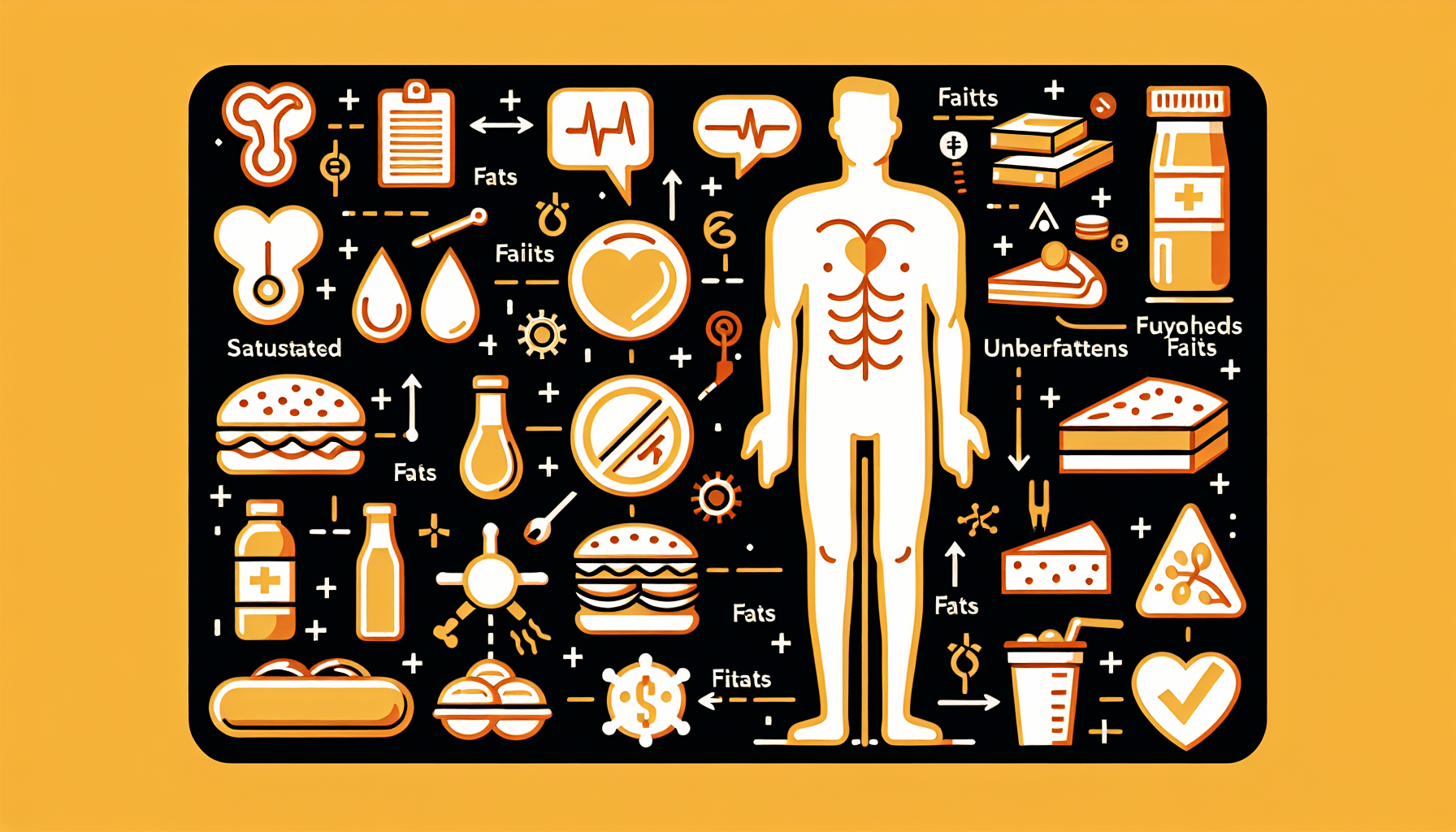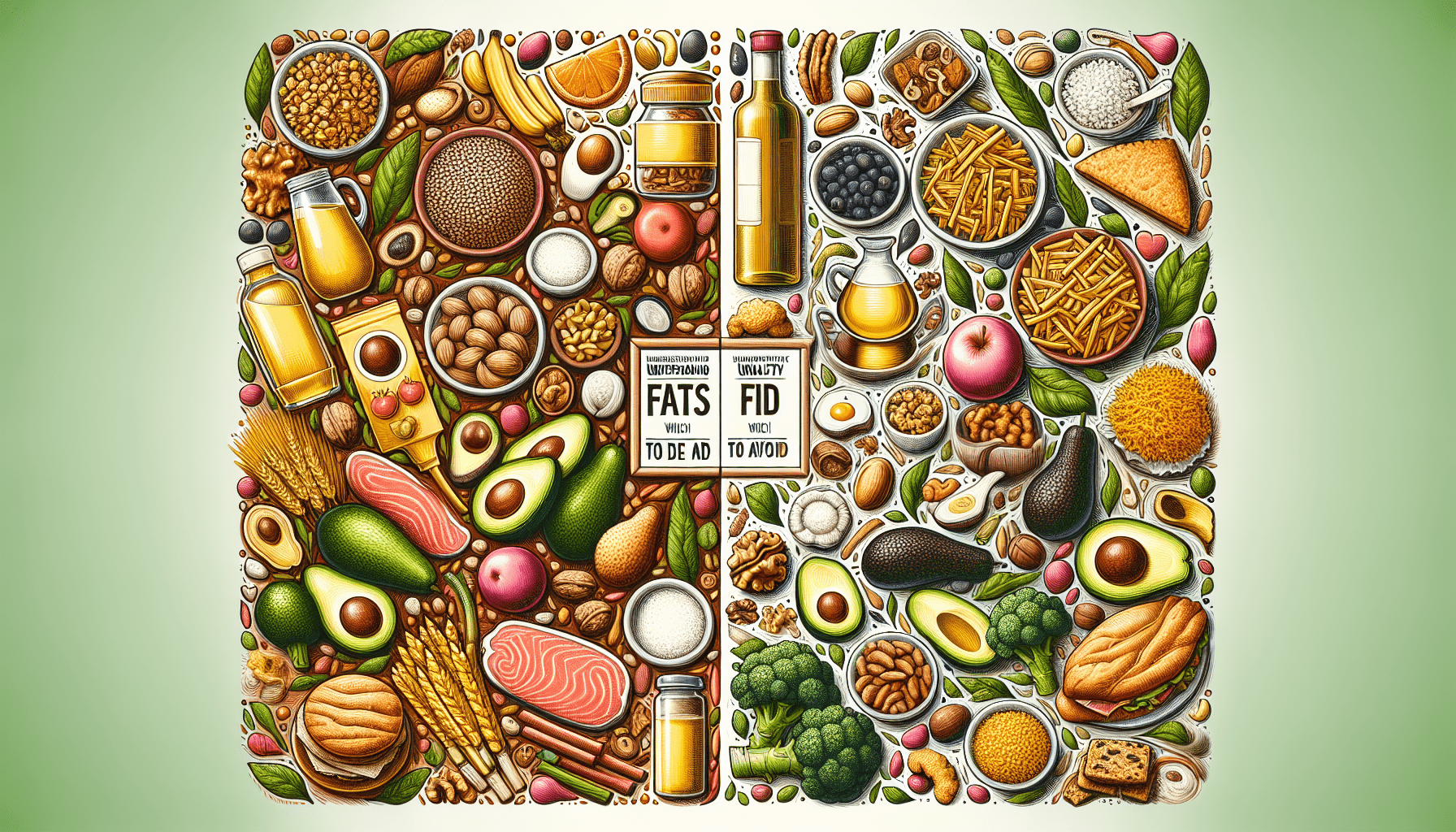In “Understanding Fats: Which To Eat And Which To Avoid,” we explore the world of fats and their impact on our health. With so much conflicting information out there, it’s crucial to distinguish between the fats that are beneficial for our bodies and the ones that can potentially harm us. This article sheds light on the different types of fats, such as saturated, unsaturated, and trans fats, and provides valuable insights on which ones to incorporate into our diet and which ones to limit or avoid. Remember, it’s always essential to consult a health professional before making any changes to your diet or exercise routine.
Discover the Ultimate Weight Loss Secrets Here!
Types of Fats
When it comes to understanding fats, it’s important to know that not all fats are created equal. Fats can be categorized into several types, each with their own unique characteristics and effects on our health. The main types of fats include saturated fats, trans fats, monounsaturated fats, polyunsaturated fats, omega-3 fatty acids, and omega-6 fatty acids. Let’s take a closer look at each of these fats and their role in our diet.
Saturated Fats
Definition and Sources
Saturated fats are a type of fat that is solid at room temperature. They are mainly found in animal products such as meat and dairy, as well as in some tropical oils like coconut oil and palm oil. Saturated fats are known for their ability to raise LDL cholesterol levels in the blood.
Health Effects
Consuming high levels of saturated fats has been linked to an increased risk of heart disease and elevated levels of LDL cholesterol. It is important to note that not all saturated fats have the same effect on our health. Some studies suggest that certain saturated fats, particularly those found in dairy products, may not have the same negative impact on our health as those from red meat or processed foods.
Recommended Intake
The American Heart Association recommends limiting the intake of saturated fats to less than 10% of total daily calories. For an average adult consuming 2,000 calories per day, this would amount to less than 22 grams of saturated fats.
Foods High in Saturated Fats
Some common foods high in saturated fats include fatty cuts of meat, whole milk and full-fat dairy products, butter, cheese, and tropical oils like coconut oil. It is important to consume these foods in moderation and choose leaner options whenever possible.
Click Here for Proven Fat-Burning Strategies!
Trans Fats
Definition and Sources
Trans fats are a type of fat that is formed through a process called hydrogenation, which converts liquid oils into solid fats. They are commonly found in processed foods, fried foods, and baked goods. Trans fats are known for their negative impact on cholesterol levels, raising LDL cholesterol while lowering HDL cholesterol.
Health Effects
Consuming trans fats has been strongly linked to an increased risk of heart disease, stroke, and type 2 diabetes. They not only raise LDL cholesterol levels but also lower HDL cholesterol, making them particularly harmful to our health.
Recommended Intake
Due to the harmful effects of trans fats, health organizations and regulatory bodies around the world recommend keeping trans fat intake as low as possible. In some countries, the use of trans fats in food production has been banned altogether.
Foods High in Trans Fats
Foods that are typically high in trans fats include commercially baked goods like pastries, cookies, and cakes, fried foods such as French fries and fried chicken, and processed snacks like chips and microwave popcorn. It is important to check food labels and choose products that are labeled as trans fat-free.
Monounsaturated Fats
Definition and Sources
Monounsaturated fats are a type of unsaturated fat that is liquid at room temperature but may solidify when refrigerated. They are found in various plant-based oils such as olive oil, canola oil, and peanut oil, as well as in avocados, nuts, and seeds.
Health Effects
Monounsaturated fats are considered heart-healthy fats as they can help lower LDL cholesterol levels and reduce the risk of heart disease. They also provide important nutrients and antioxidants that are beneficial for overall health.
Recommended Intake
There is no specific recommended intake for monounsaturated fats, but they should be included as part of a healthy balanced diet. They can replace unhealthy fats in the diet, such as saturated and trans fats.
Foods High in Monounsaturated Fats
Foods that are high in monounsaturated fats include olive oil, canola oil, avocados, almonds, peanuts, and sesame seeds. Adding these foods to your diet can help increase your intake of beneficial monounsaturated fats.

Unlock Your Path to a Healthier You!
Polyunsaturated Fats
Definition and Sources
Polyunsaturated fats are another type of unsaturated fat that is found in liquid form at room temperature and when refrigerated. They are mainly found in plant-based oils such as soybean oil, corn oil, and sunflower oil, as well as in fatty fish.
Health Effects
Polyunsaturated fats are beneficial for heart health as they help lower LDL cholesterol levels and reduce the risk of heart disease. They also contain essential fatty acids, such as omega-3 and omega-6 fatty acids, which play crucial roles in various bodily functions.
Recommended Intake
Polyunsaturated fats should be included as part of a healthy balanced diet. The American Heart Association recommends that these fats should make up about 10% of total daily calories.
Foods High in Polyunsaturated Fats
Foods that are high in polyunsaturated fats include fatty fish like salmon, mackerel, and trout, as well as soybean oil, corn oil, sunflower oil, and walnuts. Incorporating these foods into your diet can help increase your intake of polyunsaturated fats.
Omega-3 Fatty Acids
Definition and Sources
Omega-3 fatty acids are a type of polyunsaturated fat that is particularly beneficial for our health. They are mainly found in fatty fish, such as salmon, mackerel, and sardines, as well as in flaxseeds, chia seeds, and walnuts.
Health Effects
Omega-3 fatty acids have been shown to have numerous health benefits. They help reduce inflammation in the body, lower triglyceride levels, decrease blood clotting, and support brain health. They are particularly beneficial for heart health.
Recommended Intake
The American Heart Association recommends consuming at least two servings of fatty fish per week to ensure an adequate intake of omega-3 fatty acids. For those who do not consume fish, omega-3 supplements can be considered, but it is always best to consult with a healthcare professional before starting any new supplements.
Foods High in Omega-3 Fatty Acids
Fatty fish are the best dietary source of omega-3 fatty acids. Other sources include flaxseeds, chia seeds, walnuts, and algae-based supplements. Incorporating these foods into your diet can help you meet your omega-3 fatty acid needs.
Omega-6 Fatty Acids
Definition and Sources
Omega-6 fatty acids are another type of polyunsaturated fat that is essential for our health. They are found in various plant-based oils, such as soybean oil, corn oil, and sunflower oil, as well as in nuts and seeds.
Health Effects
Omega-6 fatty acids play a crucial role in brain function, growth, and development. They also help regulate metabolism and support the immune system. However, it is important to maintain a healthy balance between omega-3 and omega-6 fatty acids, as an imbalance can contribute to inflammation and certain health conditions.
Recommended Intake
There is no specific recommended intake for omega-6 fatty acids, as they are widely available in the Western diet. However, it is important to limit the intake of omega-6 fatty acids if it exceeds the intake of omega-3 fatty acids.
Foods High in Omega-6 Fatty Acids
Foods that are high in omega-6 fatty acids include soybean oil, corn oil, sunflower oil, and most nuts and seeds. It is important to consume these foods in moderation and maintain a balance between omega-3 and omega-6 fatty acids.
Role of Fats in the Body
Now that we have discussed the different types of fats, let’s explore the role that fats play in our bodies. Fats serve several important functions that are crucial for our overall health and well-being.
Energy Source
Fats are a concentrated source of energy, providing more than twice as many calories per gram compared to carbohydrates and proteins. They serve as a stored energy source, providing fuel for our bodies during times of fasting or prolonged exercise.
Component of Cell Membranes
Fats are an essential component of cell membranes. They help maintain the integrity and fluidity of cell membranes, allowing nutrients to enter the cells and waste products to exit.
Absorption of Fat-Soluble Vitamins
Certain vitamins, such as vitamins A, D, E, and K, are fat-soluble, meaning they need fat in order to be absorbed and utilized by the body. Fats help transport these vitamins and enhance their absorption.
Hormone Production
Fats play a vital role in hormone production. They are involved in the synthesis of various hormones, including sex hormones and hormones that regulate appetite and metabolism.

Determining the Healthiest Fats
When it comes to choosing the healthiest fats for our diet, it’s important to understand how to read labels and distinguish between different types of fats.
Understanding Labeling
Food labels can be helpful in determining the types and amounts of fats present in a particular product. Look for terms like “saturated fat,” “trans fat,” “monounsaturated fat,” and “polyunsaturated fat” on the nutrition facts panel. Additionally, check the ingredient list for any sources of unhealthy fats, such as hydrogenated or partially hydrogenated oils, which indicate the presence of trans fats.
Total Fat vs. Specific Fats
While it’s important to monitor our total fat intake, it is equally important to pay attention to the types of fats we consume. Aim for a balance between saturated fats, monounsaturated fats, and polyunsaturated fats in your diet. Limiting saturated and trans fats while incorporating more unsaturated fats can help improve your overall health.
Optimal Fat Ratios
There is no one-size-fits-all recommendation for the ideal fat ratios in a diet. However, most health organizations recommend consuming a higher proportion of unsaturated fats, including monounsaturated and polyunsaturated fats, while limiting saturated and trans fats.
Balancing Essential Fatty Acids
To ensure optimal health, it is important to strike a balance between omega-3 and omega-6 fatty acids. Most Western diets tend to be high in omega-6 fatty acids and low in omega-3 fatty acids, which can contribute to chronic inflammation. To promote a healthier balance, increase your intake of omega-3-rich foods or consider omega-3 supplements, while moderating your intake of omega-6 fats.
Avoiding Unhealthy Fats
While fats are an essential part of a healthy diet, certain fats should be limited or avoided altogether to maintain optimal health.
Limiting Saturated and Trans Fats
Saturated fats and trans fats should be limited in the diet to reduce the risk of heart disease and other chronic conditions. Choose lean cuts of meat, low-fat dairy products, and healthier cooking oils in place of those high in saturated fats. Avoid or minimize the consumption of processed foods, fried foods, and baked goods that contain trans fats.
Choosing Lean Sources of Protein
When it comes to protein sources, opt for lean meats, skinless poultry, fish, legumes, and low-fat dairy products. These choices provide essential nutrients without the unhealthy saturated fats often found in higher-fat cuts of meat.
Avoiding Processed and Fried Foods
Processed and fried foods are often high in unhealthy fats, including trans fats. These foods are typically calorie-dense, low in nutrients, and can contribute to weight gain and other health problems. Opt for healthier alternatives such as fresh fruits and vegetables, whole grains, and homemade meals prepared with healthier cooking methods, such as baking, grilling, or steaming.
Reading Food Labels
Reading food labels is crucial in identifying and avoiding unhealthy fats in various products. Look for foods labeled as “trans fat-free” or “low in saturated fat” to guide your choices. Additionally, scan the ingredient list for any hidden sources of unhealthy fats.
In conclusion, understanding the different types of fats and their effects on our health is essential for making informed dietary choices. By choosing healthier fats and avoiding or limiting unhealthy fats, you can maintain a balanced and nutritious diet that supports your overall well-being. Remember to consult a health professional before making any changes to your diet or exercise routine to ensure it is tailored to your individual needs. Stay healthy and enjoy your journey towards a well-balanced diet!


